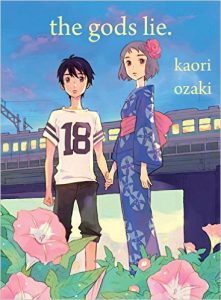Sakura Hime Volumes 1-4 by Arina Tanemura
One of my reading goals over winter vacation was to make some headway into some of the series that I’ve been hoarding but not finishing. The main ones I’ve had around the house are 07-Ghost, Magi, and Sakura Hime. Since Sakura Hime is the shortest, I decided to start with that. Also, for someone that genuinely loves Arina Tanemura manga as much as I do, it is just plain weird that I haven’t finished the series before now. I didn’t reach my goal of reading the entire series during winter vacation but I hope to whittle away at it over the next couple months.
Sakura is a 14 year old princess from the moon who is engaged to Prince Oura, the son of the emperor. She is extrmely unhappy about her upcoming marriage. Hanging out in a tree in protest, she falls into the arms of Aoba, a handsome and obnoxious emissary who has come to escort her to her new husband. They immediately start bickering in that “I hate you because I’m secretly attracted to you!” way that so often happens in shoujo romance. And in a not very great surprise, Aoba is actually Oura.
Sakura and Aoba are fighting from the start, as he thinks that she has the potential to turn into an evil demon due to her moon heritage, while Sakura is determined to protect humans. Demons called youko attack Sakura if she looks directly at the moon, and she is able to manifest magical girl powers when she calls on the somewhat cranky sword Chizakura. One interesting aspect of this manga is that each character has a unique soul symbol that defines their lives. Sakura’s is “Destroy” which highlights the tension between her otherworldly nature and her desire to protect humanity. It also feeds into Aoba’s worries that Sakura is dangerous.
A large supporting cast is introduced at a quick pace in the first few volumes, including the tiny mononoke Asagiri, who is a companion to Sakura. Sakura is also joined by a spunky ninja protector named Kohaku, who has a companion frog named Hayate who is actually a handsome ninja boy with an unfortunate curse. The Priestess Byakura serves in the role of mystical advisor. Lord Fujimurasaki shows up to hint at love triangle possibilities, and just be generally fabulous with a tendency to compose random poems as commentary on whatever is happening around him.
One thing I was surprised about as the story unfolded is that the relationship between Aoba and Sakura ends up evolving greatly in the first few volumes, as based on patterns in other Tanemura series, I expected the “I hate you, no I love you” dynamic to continue for at least 6-7 volumes. Sakura grows in capabilities and confidence as she continues to reclaim her heritage as a princess from the moon. It wouldn’t be a Tanemura series if the heroine wasn’t spending a great deal of time stressing out over a man so since the situation with Aoba is quickly resolved, Sakura’s long-lost brother Enju appears and takes her away.
Tanemura does a good job juggling the character relationships with such a large cast, and in the first few volumes she has moments of levity balanced with some serious mystical creepiness. The moon is a creepy, creepy place. Sakura’s good human companions are balanced out by Enju’s followers, and I’m looking forward to the coming conflict in the rest of the series. I had to laugh when I was reading one of the authors’ notes, as Tanemura commented that she was using less screentone, and I have to say I can’t see it. The combination of historical setting, magical girl hijinks, and moon people ensures that all the flowing ribbons and fluttering flower petals that Tanemura fans would expect are present in this series. After reading the first few volumes, I’m enjoying it very much.






Recent Comments